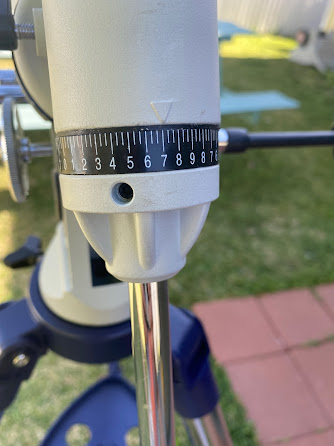As the proud owner of a 130-mm (5-inch) Newton reflector with tabletop Dobsonian mount from Astronomers Without Borders, I have been taking advantage of the clear nights to learn the new instrument. Collimating the mirrors was always a challenge for me. I will check them again one more time before going out tonight.
Geographically, I live in a suburb, but my skies are urban by definition: No part of the Milky Way is visible – Bortle 8/10. The last couple of nights and early mornings out, I counted about 60 to 70 stars. The brightest constellations, Leo and the Big Dipper, begin the tally, but only the top of Scorpius is available, though I have seen the stinger stars Lesath and Shaula. I have not seen Ptolemy’s Cluster (Messier 7) naked eye here lately though I often did in the city. (That sector of the sky was more available in the winter mornings because the zodiac was higher.)
 |
| National Geographic 76-mm Newtonian. Not sure that it was worth $100. |
I also bought a National Geographic 76-mm tabletop Newtonian. It has been a disappointment. I do have 70-mm refractors with which I have seen double stars and open clusters. This will not do that. I tried better oculars costing twice what this tube did but they were no help. And, on point, with those small refactors, I also tried the views with the cheaper default eyepieces—Huygens, Ramsden, and Kellner—and been successful, albeit not thrilled. Even so, I attached a small telescopic crosshairs sight to the Natl G 76mm Newt and it helps to find the targets. Found, they remain blurred and sparkly and no doubles were split.
That being as it is, the AWB 130-mm has been an eye-opener.
I started in November 2014 with a 130mm Celestron reflector but after struggling repeatedly with collimation, I donated it to the Goodwill in early 2021 after buying myself a new refractor in October 2020. (On my blog here. ) I have been very happy with the Explore Scientific 102-mm achromatic refractor and it has been my “grab-n-go” these past 18 months. However, I am also a sustaining member of Astronomers Without Borders and they sell this tabletop Dobsonian*. Finally settled in our new home, I bought one. I am glad that I did.
First of all, it came with a collimation eyepiece and clear instructions, which I already know well enough (in theory). The default eyepieces are called SMA: Symmetric Modified Achromatic (Kellner), basically, a three lens design that reverses the order of the traditional Kellner so that the lens curves face each other. They are fine for what they are. However, I have been using my very much better oculars from Nagler, Stellarvue, Vixen, and Meade.
On the first night, 26 May 2022, I split delta Corvii, and then the Mizar-Alcor system, both easy targets. I was pleasantly surprised to quickly find both Messier 80 and Messier 4 in Scorpius. The first, I logged several times already and noted that it appears when Messier 4 does not. (Such clusters are difficult under city lights.) However, M4 was right there were I expected it, west of Antares. Both gave sparkly hints of their central cores with dusty envelopes at the outskirts.
The next night, 27 May 2022, I split Castor and Algieba (gamma Leonis) with a 14mm eyepiece (46X), but found the collimation still off.
On the 28th, I recollimated in the afternoon. I checked the red-dot finder alignment on delta Corvii with a 7-mm (93X) eyepiece. I then performed a “star test” on Spica, running the focus far out so that the star was a very large circle showing the shadow of the secondary mirror and yielding symmetric Airy Disks at the diffraction limits. The collimation is still a little off-center but the viewing was acceptable.
2215 hours: Gamma Corvii is a blue supergiant and it was very bright and very white. I did not find Messier 68 below Beta Corvii, a frequent source of disappointment with my refractor, also.
2251 to 2309 hours: However, once Scorpius was up, I found Messier 80 and Messier 4 easily and spent time viewing them with a 4mm (165X) Stellarvue 82-degree eyepiece. Unfortunately, not much of Scorpius below Antares was visible.
2317: Lyra was not apparent as a constellation in the east though Vega was impossible to miss and from there both Zeta Lyrae and Epsilon Lyrae double star systems were accessible. Epsilon Lyrae is everyone’s favorite, a “double double” each star with a companion, and I noted them in my log book.
2344 to 2353: Scanning Scorpius again, I found Mu Scorpii, a naked-eye double. Lesath and Shaula (Upsilon and Lambda Scorpii) were visible but there was no outline to the “Teapot” of Sagittarius, and I could not make Zeta Scorpii naked eye. I did not try for its open cluster which I have logged in the past.
* [Note: It was the late John Dobson (1915-2014) who pioneered large reflector telescopes on wooden “lazy susan” swivel mounts. He ground the mirrors from porthole plate glass retrieved from ship salvage yards. After living in a Hindu monastery, he took his astronomy to the streets. See Wikipedia here: https://en.wikipedia.org/wiki/John_Dobson_(amateur_astronomer) and YouTube here: https://www.youtube.com/watch?v=bVbX19kabNc ]
PREVIOUSLY ON NECESSARY FACTS
Seeing in the Dark: Your Front Row Seat to the Universe
Steven Weinberg on Gravity Waves
Galileo and Saturn: Epistemology not Optics






.jpeg)